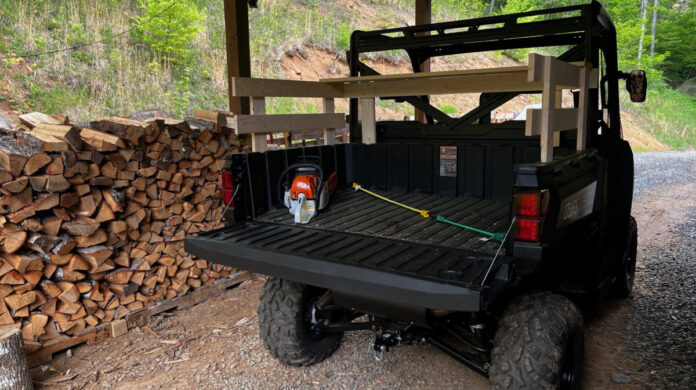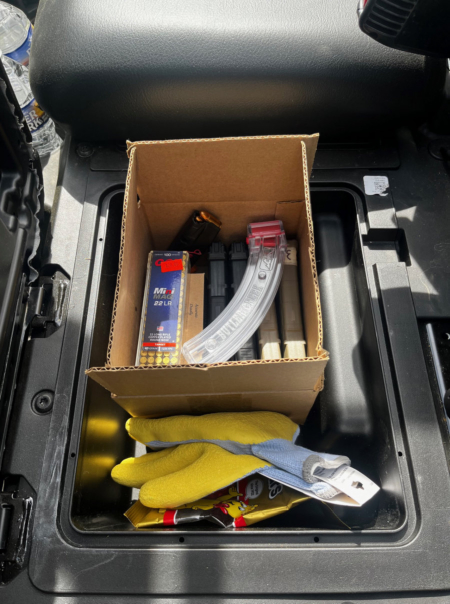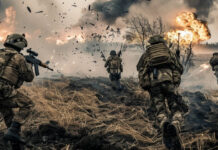
As planned, I built the wood rail system for the bed of our new Polaris Ranger, as seen in the primary image, above. The side of the bed had holes sized perfectly for a 1”x4” piece of lumber. I initially thought the holes were too shallow, but after trying them out, they held the wood securely. My biggest challenge was the wood occasionally split while making it, even after I started pre-drilling holes for the screws. I had purchased an extra piece “just in case,” and it came in handy. The rail is installed an in use, but I may paint or stain it to add some weather protection.
I threw in a few bungee cords to help me strap down a load. Two are in the bed where there are multiple tie-down points and two more are stored in a basket built into the dashboard.
A big addition was two side mirrors which make backing up the driveway or into the garage much easier. They do not, of course, show me what is immediately behind the vehicle. I guess the backup camera on my truck has spoiled me. The mirrors cost just $32 on eBay, and I am very satisfied with them. The mirrors on sale at the Polaris website are $180, which is why I am buying my accessories from third parties.
The headrests and metal frame on the back of the cab make it difficult to see when I crane my head around to look behind me, and the wooden rail I added on that piece of the bed isn’t helping. I will try it with the side mirror for a while and consider removing the end portion of rail I necessary. So far, the side mirrors are proving to be sufficient.
Vehicle Preps
I expect to be driving this within three miles of our house, so it’s not like I need to equip the vehicle for a serious long-term emergency. Placing two water bottles in the cup holders will address what I expect will be my biggest need while in the field. I also included a five-ounce bag of Haribo gummy bears, which are my go to if I need a sugar lift or quick burst of energy.
I am considering adding a fire extinguisher. They seem to be common equipment on UTVs. I don’t see this as a huge need for this, but it could be useful if the spark arrestor fails and some leaves catch on fire.
After I rebuild rebuild my bank account, I will add a winch and some other accessories. Adding a windshield will also add a degree of protection from branches or anything that might strike me while underway. In the meantime, we’ve trimmed away most of them.
While I will often carry a chainsaw, I don’t expect it will be in there all the time, so I stashed a hatchet under the passenger seat, just in case I need to hack something out of my way. I haven’t figured out where or how to mount a shovel or spade.
As I use the vehicle more, I expect I will find out what I need and what I don’t need.
Ammo Stash
While I am not comfortable leaving a gun on or in an unattended vehicle that has no doors, I added spare ammo under the seat, just in case. I don’t expect to get in a running gun fight from the Polaris, but on the theory that you can never have too much ammo, I put together a bundle of spare ammo for that worst-case scenario.

To prevent it from bumping around and being noisy, I placed it all in a cardboard box with some packing foam. I included a loaded Glock 48 magazine, which is my standard EDC, plus a box of 50 rounds of 9mm. For rifles, I have two 30-round mags of 5.56 and two magazines of .300 Blackout. Then I tossed in 100 rounds of CCI 22LR Mini Mags and a 25-round extended magazine for the 10/22. That should cover all the guns I am likely to bring with me. Yes, I could add .308, .38/357, .40, .45, and 12 gauge ammo, but I don’t see myself grabbing any of those guns in a rush.
To help tell Magpul 5.56 magazines apart from those loaded with .300 Blackout, I use only coyote tan magazines for .300BO, and I label them. The furniture on my .300 ARs is also coyote tan, which helps me identify them at just a glance. It is entirely possible that my wife would be carrying an AR in 5.56 and I would be carrying one in .300BO, so the color differences are key to making sure no one shoves the wrong ammo in their gun.
First Aid
I drove up the mountain with a fellow who works as a forester to see if he was willing to help me remove the trees that fell down on and around our spring. He was, and we’ll be using the Polaris to get up and down the mountain. By help, let me clarify that he’ll be doing the bulk of the felling and sawing and I will be loading logs into the back of the Polaris and tossing branches down the mountain.
This new task made it important that I put together a first aid kit suitable for treating more than just a splinter or cut. The challenge was doing it without cannibalizing any existing medical or trauma kits.
As I found out a year ago while at a public event where somebody feinted, my trauma kits are designed to address bullet wounds and car crashes rather than heat exposure. (I have since added oral rehydration salts and drink powders.) I want this kit to be able to stabilize chain saw injuries, blunt trauma caused by a falling tree or snapping branches, or possibly damage from a self-inflected axe wound. So this kit will have a CAT tourniquet and at least one six-inch Israeli bandage in it. I did not include a chest seal or airway, however, because I have a limited number and felt this kind of injury was less likely.
After sorting through our big plastic bin of emergency medical supplies, I included lots of gauze, a variety of bandages in different sizes, some ACE-type wraps, tape, and what I know of as vet wrap, which works just as well for humans as it does pets. I also have some common “snivel kit” items, including antibiotic ointment, Band-Aids, ibuprofen, etc. =
The biggest thing I am missing is a nice red or blue medic bag. I threw everything into a small sling bag. It will suffice, and it will fit under the passenger seat.






